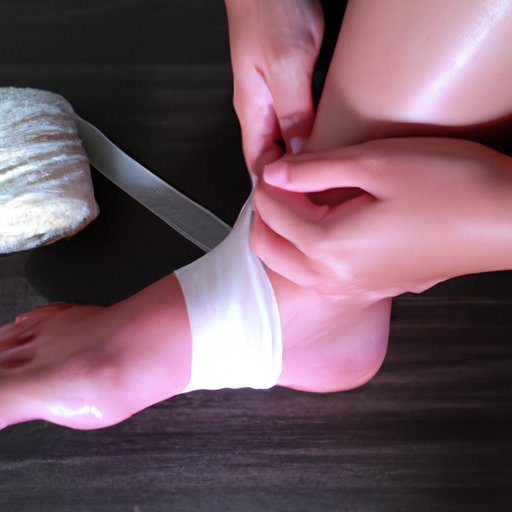
Introduction
Sprained ankles are a common injury that can happen to anyone, young or old, athlete or couch potato. They occur when the ligaments that support the ankle are stretched or torn due to sudden twisting or rolling of the foot. While ankle sprains are not typically serious, they can be painful and cause significant swelling and discomfort. In this article, we will explore the symptoms, treatment, and recovery process for a sprained ankle to help you identify and manage this common injury.
Symptoms to Look For
The most common symptoms of a sprained ankle include swelling, bruising, tenderness, and difficulty bearing weight on the affected foot. The ankle may also feel stiff and unstable, and there may be a popping or tearing sensation at the time of injury. It is important to note that these symptoms may also be present in more serious injuries, such as fractures or dislocations.
To differentiate a sprain from a more severe injury, it is important to pay attention to the severity and duration of each symptom. If you experience severe pain, inability to walk or bear weight on the ankle, or if the pain and swelling do not improve within a couple of days, you should seek medical attention.
At home, you can manage pain and swelling by using ice and taking over-the-counter pain medication. It is best to rest and avoid activities that exacerbate the pain until the ankle has a chance to start healing.
Types of Sprains
There are three main types of ankle sprains: lateral, medial, and high ankle sprains. Lateral sprains are the most common and occur when the ankle rolls inward, stretching or tearing the ligaments on the outside of the ankle. Medial sprains are less common and occur when the ankle rolls outward, stretching or tearing the ligaments on the inside of the ankle. High ankle sprains are the least common but the most severe, as they involve the ligaments that hold the two bones of the lower leg together.
The symptoms and treatment for each type of sprain will vary depending on the location and severity of the injury. Lateral and medial sprains are typically treated with rest, ice, and compression, while high ankle sprains may require more intensive medical attention, such as immobilization or surgery.
If you suspect that you have a sprained ankle, it is important to seek medical attention to ensure an accurate diagnosis and proper treatment plan.
Diagnosing a Sprained Ankle
In order to diagnose a sprained ankle, a doctor will perform a physical exam and ask about the nature of the injury. X-rays and MRI may also be used to confirm the diagnosis and rule out more severe injuries, such as fractures or dislocations.
During the exam, the doctor will look for signs of swelling, tenderness, and instability in the ankle. They may also perform mobility tests to determine the range of motion and level of pain in the affected area. Based on their findings, they will recommend an appropriate treatment plan to help the injury heal.
RICE Treatment 101
RICE (rest, ice, compression, and elevation) is a basic and effective approach to treating a sprained ankle. The goal of RICE is to reduce pain and inflammation and promote healing.
Rest: Keep weight off the ankle and avoid activities that exacerbate the pain. Use crutches if necessary.
Ice: Apply ice packs (or a bag of frozen vegetables if you don’t have ice) to the ankle for 20 minutes at a time, every 2-3 hours, for the first 72 hours after the injury.
Compression: Use a compression bandage or wrap to help reduce swelling and provide support to the ankle. Be careful not to wrap the ankle too tightly, as it can impair circulation.
Elevation: Keep the ankle elevated above the level of the heart whenever possible to help reduce swelling and promote healing.
By following the RICE method, you can help ensure a speedy and full recovery from your sprained ankle.
Recovering From a Sprained Ankle
To fully recover from a sprained ankle, it is important to take the healing process seriously. It is important to allow enough time for the ankle to heal before returning to activities or sports. Rushing back too soon can re-injure the ankle and delay recovery even further.
In addition to RICE treatment, there are a number of exercises and stretches that can help rebuild strength and flexibility in the ankle. Your doctor or physical therapist can recommend specific exercises that are appropriate for your injury and recovery level.
Preventing future injuries is also important. Wearing appropriate footwear and avoiding uneven surfaces can help reduce the risk of spraining your ankle again in the future.
Conclusion
If you suspect that you have a sprained ankle, it is important to take the injury seriously and seek appropriate medical attention. By following the RICE method and allowing enough time for the ankle to heal, you can ensure a full and speedy recovery. Remember to take steps to prevent future injuries, so you can stay healthy and active for years to come.
If you suspect a more severe injury or experience prolonged symptoms, seek medical attention right away.




